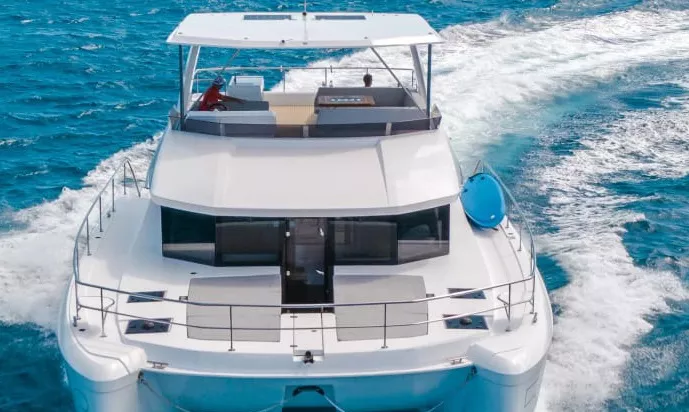A power catamaran is a type of boat characterized by its two parallel hulls, known as a twin-hull design, and is propelled by engines rather than sails. This design offers unique advantages over traditional monohull boats, including enhanced stability, increased space, and improved fuel efficiency. Power catamarans have gained popularity among boating enthusiasts for both recreational and commercial purposes.
What Is A Power Catamaran?
Twin-Hull Configuration
The defining feature of a power catamaran is its twin-hull structure. Unlike monohull boats that rely on a single hull, catamarans distribute buoyancy across two hulls. This configuration reduces water resistance, allowing for smoother and more efficient movement through the water. The space between the hulls, known as the tunnel, plays a crucial role in the vessel’s performance and stability.
Beam Width and Stability
Power catamarans typically have a wider beam—the width of the boat at its widest point—compared to monohulls. This increased width enhances the vessel’s stability, making it less prone to rolling in rough seas. The wide beam also contributes to more spacious deck areas, providing ample room for passengers and equipment.
Shallow Draft
Another notable feature is the shallow draft of power catamarans, which refers to the vertical distance between the waterline and the bottom of the hull. A shallow draft enables these vessels to navigate in shallow waters, granting access to areas that deeper-draft boats cannot reach. This is particularly advantageous for coastal cruising and exploring secluded bays.
Advantages of Power Catamarans
Enhanced Stability and Comfort
The twin-hull design provides exceptional stability, reducing the side-to-side motion commonly experienced on monohull boats. This stability enhances passenger comfort, especially in rough waters, and reduces the likelihood of seasickness. The reduced wave impact leads to a smoother ride, making power catamarans a preferred choice for long voyages.
Spaciousness and Layout
The expansive beam of power catamarans allows for larger living spaces, cabins, and storage areas compared to monohulls of similar length. This design offers more usable deck space, making it ideal for social gatherings, sunbathing, and recreational activities. The additional interior volume provides greater comfort for extended stays on the water.
Fuel Efficiency and Performance
Power catamarans are generally more fuel-efficient than monohull boats. The reduced hydrodynamic resistance due to the twin-hull design allows for better fuel economy, enabling longer trips without frequent refueling. Additionally, many power catamarans can achieve higher speeds with less horsepower, offering both efficiency and performance.
Safety and Redundancy
Having two separate hulls and engine systems adds an extra layer of safety. In the event of an engine failure in one hull, the vessel can still operate using the other, allowing it to reach safety without assistance. This redundancy is a significant advantage for those undertaking long-distance voyages or operating in remote areas.
Disadvantages of Power Catamarans
Higher Initial Cost
One of the primary disadvantages of power catamarans is their higher initial cost compared to monohull boats of similar size. The complexity of the twin-hull design and the additional materials required contribute to the increased price. Prospective buyers should consider this factor when evaluating their options.
Docking and Marina Space
The wide beam of power catamarans can pose challenges when docking or securing marina space. Many marinas are designed with monohull boats in mind, and the extra width of a catamaran may require special accommodations or incur additional fees. This consideration is important for those planning to dock in crowded or traditional marina settings.
Handling Characteristics
While power catamarans offer excellent stability, they can exhibit different handling characteristics compared to monohulls. For instance, during sharp turns, catamarans may bank outward rather than inward, which can feel unusual to operators accustomed to monohulls. Additionally, in certain sea conditions, catamarans can experience wave slamming between the hulls, leading to discomfort and noise.
Applications of Power Catamarans
Recreational Use
Power catamarans are popular choices for recreational boating activities, including cruising, fishing, and water sports. Their stability and spaciousness make them ideal for family outings and social events on the water. The ability to navigate shallow waters allows for exploration of diverse coastal environments.
Commercial Use
In the commercial sector, power catamarans are utilized for passenger ferries, tour boats, and even as support vessels in offshore industries. Their efficiency, capacity, and stability make them suitable for transporting goods and people safely and comfortably. The redundancy of twin engines is particularly valued in commercial operations where reliability is paramount.
Conclusion
Power catamarans stand out in the maritime world due to their twin-hull design, offering notable advantages such as enhanced stability, spacious layouts, and improved fuel efficiency. These features make them appealing for both recreational and commercial use. However, potential challenges like higher initial costs, docking complexities due to their wider beam, and unique handling characteristics should be considered. As the industry advances, innovations in sustainable technologies and AI integration are shaping the future of power catamarans, promising even more efficient and personalized boating experiences. For those seeking a vessel that combines comfort, performance, and modern advancements, power catamarans present a compelling option.

